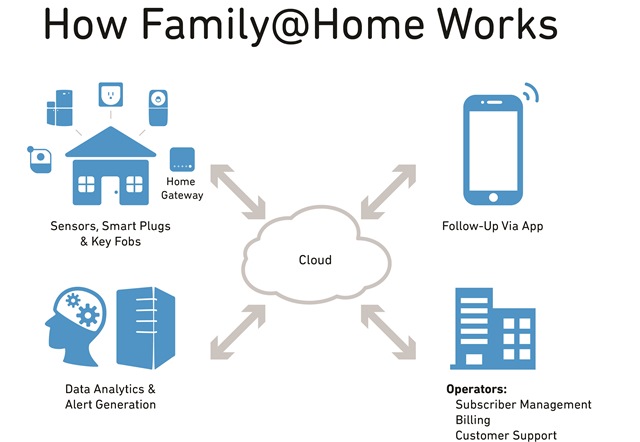By CEES LINKS,
General Manager,
Qorvo Low Power Wireless,
www.qorvo.com
In April 2016, Comcast released an interesting report, The Safe & Smart Home: Security in the Smart Home Era, compiled from almost 1,300 U.S. consumers. That report provides valuable insight into why customers are interested in smart home services, what features they really want, and how they plan to use smart home technologies. The big takeaway from this report is that what consumers really want in the smart home is services — smart home as a service — not a bunch of connected devices that remotely control various widgets and devices in the home. Thus, it’s important for the industry to start thinking about the Smart Home as a Service — SHaaS.
How should a smart home work?
First, there is a big difference between a connected device and a smart device. To convert a basic connected device to a smart device requires three additional capabilities. A smart device must be:
1. Able to connect to and communicate with other smart or connected devices in the home. The security system needs to be able to exchange data and commands with the home’s environmental controls (i.e., heating and air conditioning), leak detection, lighting, entertainment, lifestyle, etc.
2. Intelligent. More than being able to be programmed to perform certain functions at certain times, a smart home solution needs to be able to recognize what is going on in a home, learn what is normal and when something unexpected happens, and take action and/or send an alert to the residents, proper authorities, caregivers, or family members.
3. Capable of having all of these functions managed from a single application on a smart phone or any other web-connected device, such as a tablet. Currently, most connected devices and appliances offer their own app to manage and control operations. However, end users will not want to shuffle through a screen full of various apps just to find out what is happening in their home. As many of us already have cluttered up our smart phone screens with pages and pages of apps, it will be painful to add, configure, and manage a handful of additional apps that do not share a common user interface or even common commands and logic.
Unified SHaaS solutions can also be more affordable than a bunch of connected devices. A SHaaS ecosystem can eliminate the overall number of sensors required, reducing redundancy and maintenance. A single sensor could be used for a variety of applications. For instance, a motion sensor could be used in a security system, for controlling lighting, for managing home environments, for controlling entertainment options, for family lifestyle, and maybe even for feeding the family pet.
The ongoing battle for ownership of the smart home and the Internet of Things market makes it quite difficult for consumers to decide which communication technology to use in their homes (Fig. 1 ). In addition to the commonly used Wi-Fi, Bluetooth, and ZigBee, some large companies are introducing proprietary, incompatible communications technologies. This makes things overly complex not only for end-users, but also for companies that develop hardware and software components destined for the smart home. If those companies guess wrong and roll out products based on a standard that does not catch on, they could be wasting very large amounts of development costs and time.

Fig. 1: In addition to the available RF standards at the communication layer, there is a great deal of competition and fighting among the industry leaders at the application layer. This competition can make it challenging for service providers and device manufacturers to decide which wireless communications technology to adopt for smart home solutions.
The SHaaS solution
Instead of a consumer having to decide which hardware and software options to implement in their home, they can simply leave it up to the providers of home services, such as Time-Warner Cable or Verizon, which already provide internet access and entertainment to consumers and businesses worldwide. These operators already have relationships with the homeowner — their routers, modems, and set-top boxes are already in the home and customers are accustomed to receiving and paying a monthly bill for services.
However, the market for providing SHaaS is not limited to just the service providers and operators. Numerous retail organizations, like Walmart, Home Depot, and Costco, which already provide some level of home services, could easily enter this market sector. So could various large security firms, insurance companies, and integrators, which could wrap up and market the entire suite of services and sell them as a unified package.
By opting for SHaaS, consumers avoid the major challenges outlined above. They don’t need to be a technology genius. By having one organization responsible for installation, setup and management, it makes it much faster to get the service up and running. In addition, if the homeowner wants to add services, such as family lifestyle or leak detection, they just need to contact their service provider and they can get it installed, ready to work with their existing service structure. A service provider can ensure that all of the controls and user interfaces are unified — all the SHaaS options can live within a single dashboard — with common commands and look-and-feel. Finally, by providing an entire range of services, the consumer does not need to know or even care about what the underlying wireless connectivity technology is. They can control and manage all aspects of what is going on in the home from one app — one dashboard, not a collection of apps scattered across your smart phone’s screen.
SHaaS’ four components
There are four basic components in a smart home as a service application. First is a network of sensors. This can be as few as four, depending on the size of the household — mounted in the bedroom and bathroom doorways, as well as in the kitchen and near the front door of the home. Comprised of either position or motion sensors, they can be used to provide a general indication of when and where movement usually occurs in the home. Additional motion and position sensors can provide additional data (i.e., position sensors on doors and windows can indicate whether the house is secure or not). Temperature sensors can help manage the environmental conditions in the home. Leak detectors mounted on appliances can provide early warning of plumbing issues.
In addition, individuals in the home can use key fobs to register entering or leaving the house and provide their exact location and movements. Similar fobs can even be used on the family’s pets to keep track of their movements. Wearables with embedded sensors can be used to provide important information for monitoring of health and safety issues.
The information derived from these sensors is then wirelessly collected by a local hub (gateway, set-top box, etc.) and securely transmitted to an intelligent cloud service that collects and analyzes the data and then is able to generate alerts to family members, caregivers, and first responders. After the initial installation of the SHaaS sensors linked to the analytics, it only takes a week or two for the algorithm in the cloud to accumulate enough data for the application to “learn” how the family lives and to be able to send alerts when an unexpected event happens or something drastically changes.
Another important component is the consumer’s management app, which can be accessed via a smart phone or any web-connected device. The important consideration is that all of the various services need to be consolidated into a single user interface, into one easy-to-use dashboard that allows the homeowner to monitor the state of their home as well as the people and pets inside.
Finally, the service provider is able to handle customer support, billing, and subscriber management as well as software and service upgrades and changes.
These four components make the smart home as a service a reality. Not only is it easy to use, simple to manage, and effective in providing the residents with safety, security, and comfort, but it also serves as a valuable generator of income for the service providers.
A real-world example
One very sophisticated SHaaS application is family lifestyle monitoring. GreenPeak (now part of Qorvo) recently announced the Family@Home system that enables residents and parents to monitor what is happening in the house (Fig. 2 ). However, it does a lot more. It is a smart system that can learn what is normal for the household and can take action if something out of the expected occurs, like the kids cutting school and coming home to have a party when the parents are not around.

Fig. 2: The family lifestyle system uses sensors, connected devices, cloud intelligence, and social media to combine a variety of important services into a simple-to-use app that enables service providers to make their customers’ lives easier and more secure.
Family@Home is like having a butler in your house who can assist the family by turning off lights and the heat when nobody is in a room or locking back doors when they were accidentally left unlocked. It is a collection of services that analyzes input from the smart home sensors, learns how the family lives and how the home is used, and can make intelligent decisions to make homes more comfortable, safer, and more energy-efficient.
About the Author

Cees Links was the founder and CEO of GreenPeak Technologies, now part of Qorvo. Under his responsibility, the first wireless LANs were developed, ultimately becoming household technology integrated into PCs and notebooks. He also pioneered the development of access points, home networking routers, and hotspot base-stations. He was involved in the establishment of the IEEE 802.11 standardization committee and the Wi-Fi Alliance. He was also instrumental in establishing the IEEE 802.15 standardization committee to become the basis for the ZigBee sense and control networking. Since GreenPeak was acquired by Qorvo, Cees has become the General Manager of the Low Power Wireless Business Unit in Qorvo.
Advertisement
Learn more about Qorvo





